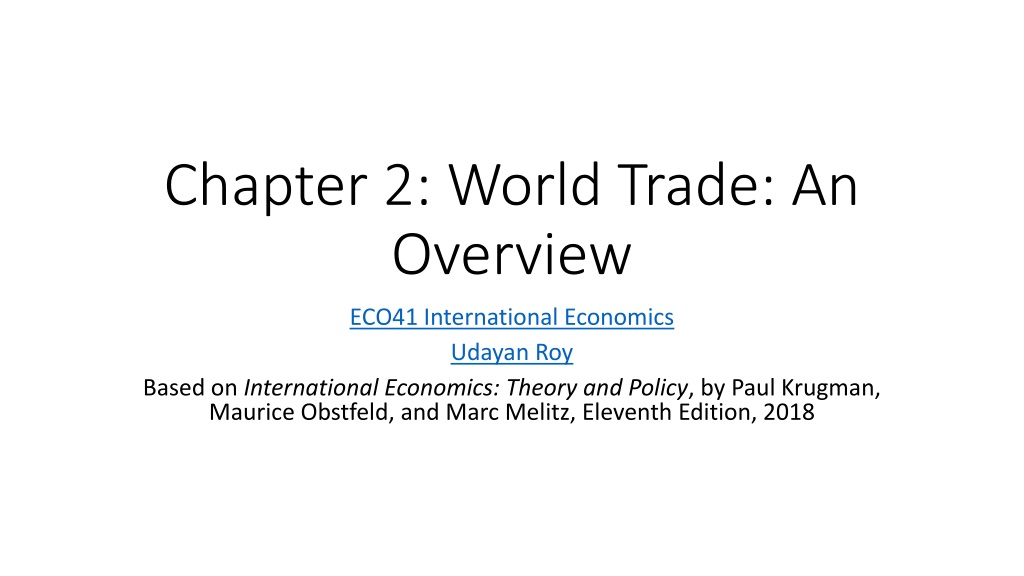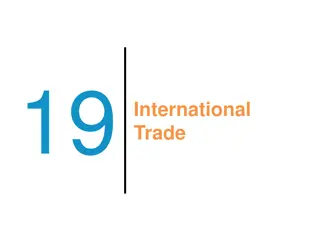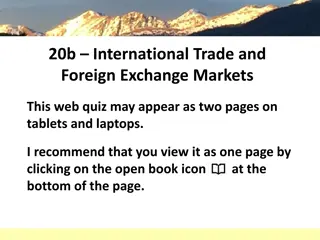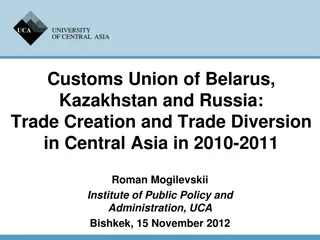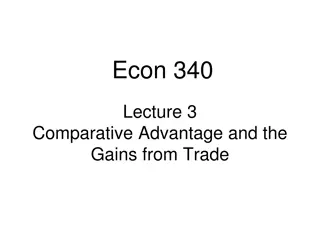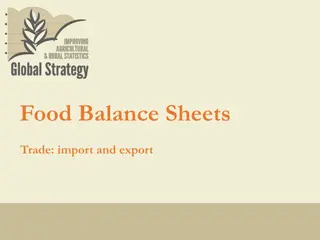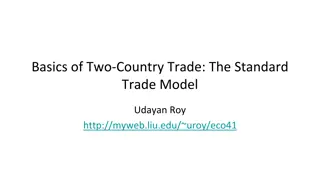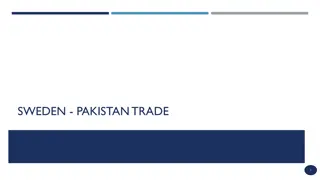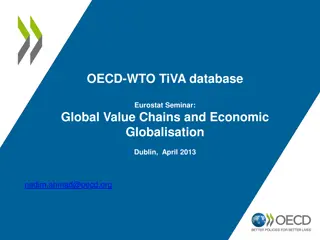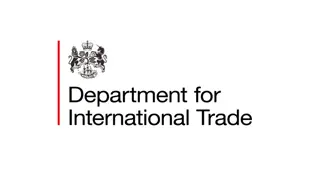Understanding World Trade Dynamics
Explore the intricacies of international trade in Chapter 2, "World Trade: An Overview," covering topics such as the Gravity Model, trade barriers, global production fluctuations, and the evolution of traded goods and services over time. Delve into who trades with whom, the impact of country size on trade, and the significance of distance and borders in shaping trade patterns. Gain insights into major trading partners of the U.S., the dynamics of U.S. trade with European economies, and the factors influencing trade relationships between countries.
Download Presentation

Please find below an Image/Link to download the presentation.
The content on the website is provided AS IS for your information and personal use only. It may not be sold, licensed, or shared on other websites without obtaining consent from the author. Download presentation by click this link. If you encounter any issues during the download, it is possible that the publisher has removed the file from their server.
E N D
Presentation Transcript
Chapter 2: World Trade: An Overview ECO41 International Economics Udayan Roy Based on International Economics: Theory and Policy, by Paul Krugman, Maurice Obstfeld, and Marc Melitz, Eleventh Edition, 2018
World Trade: An Overview Who Trades with Whom? Size Matters: The Gravity Model Using the Gravity Model: Looking for Anomalies Impediments to Trade: Distance, Barriers, and Borders The Changing Pattern of World Trade Has the World Gotten Smaller? What Do We Trade? Service Offshoring Do Old Rules Still Apply?
Learning Objectives 2.1 Describe how the value of trade between any two countries depends on the size of these countries economies and explain the reasons for that relationship. 2.2 Discuss how distance and borders reduce trade. 2.3 Describe how the share of international production that is traded has fluctuated over time and why there have been two ages of globalization. 2.4 Explain how the mix of goods and services that are traded internationally has changed over time.
Who Trades with Whom? More than 30% of world output is sold across national borders. The 5 largest trading partners with the U.S. in 2015 were China, Canada, Mexico, Japan, and Germany. The largest 15 trading partners with the U.S. accounted for 75% of the value of U.S. trade in 2015.
Figure 2.1 Total U.S. Trade with Major Partners, 2015 U.S. trade measured as the sum of imports and exports of goods is mostly with 15 major partners. Source: U.S. Department of Commerce. What does this chart suggest are the factors that determine whether two countries will trade a lot or only a little with each other?
Size Matters: The Gravity Model (1 of 3) 3 of the top 10 trading partners with the U.S. in 2012 were also the 3 largest European economies: Germany, the United Kingdom, and France. Why does the United States trade more with these European countries than with others? These countries have the largest gross domestic product (GDP), the value of goods and services produced in an economy, in Europe. Each European country s share of U.S. trade with Europe is roughly equal to its share of European GDP.
Figure 2.2 The Size of European Economies, and the Value of Their Trade with the United States Shows the correspondence between the size of different European economies and those countries trade with the United States. Source: U.S. Department of Commerce, European Commission.
Size Matters: The Gravity Model (2 of 3) The size of an economy is directly related to the volume of its imports and exports. Larger economies produce more goods and services, so they have more to export. Larger economies generate more income from the goods and services sold, so they are able to import more. Trade between any two countries is larger, the larger is either country.
Size Matters: The Gravity Model (3 of 3) The gravity model is an equation that guesses the amount of trade between countries i and j: ???=? ?? ?? ??? where A is a constant term (estimated) Tij is the value of trade between country i and country j Yi the GDP of country i, Yj is the GDP of country j Dij is the distance between country i and country j Or more generally, ???=? ??? ??? ? ??? where a, b, and c are constants, not necessarily equal to 1, estimated from data.
Using the Gravity Model: Looking for Anomalies A gravity model fits the data on U.S. trade with European countries well, though not perfectly. The Netherlands, Belgium and Ireland trade much more with the United States than predicted by a gravity model. Ireland has strong cultural affinity due to common language and history of migration. The Netherlands and Belgium have transport cost advantages due to their location and geography.
Impediments to Trade: Distance, Barriers, and Borders (1 of 4) Other things besides size matter for trade: 1. Distance between markets influences transportation costs and therefore the cost of imports and exports. 2. Cultural affinity: close cultural ties, such as a common language, usually lead to strong economic ties. 3. Geography: ocean harbors and a lack of mountain barriers make transportation and trade easier. 4. Trade agreements: countries can sign agreements to reduce trade barriers such as import taxes called tariffs between them. 5. Borders: crossing borders involves formalities that take time, often different currencies need to be exchanged, and perhaps monetary costs like tariffs reduce trade.
Impediments to Trade: Distance, Barriers, and Borders (2 of 4) Estimates of c, the effect of distance from the gravity model, predict that a 1% increase in the distance between countries is associated with a decrease in the volume of trade of 0.7% to 1%. Besides distance, international borders increase the cost and time needed to trade. Trade agreements between countries reduce the formalities and tariffs needed to cross borders, and therefore increase trade.
Impediments to Trade: Distance, Barriers, and Borders (3 of 4) The U.S. signed a free trade agreement with Mexico and Canada in 1994, the North American Free Trade Agreement (NAFTA). NAFTA was replaced by the United States-Mexico-Canada Agreement (USMCA), which entered into force on July 1, 2020 and is essentially similar to NAFTA Because of NAFTA and because Mexico and Canada are close to the U.S., the amount of trade between the U.S. and its northern and southern neighbors as a fraction of GDP is larger than between the U.S. and European countries. Canada s economy is roughly the same size as Spain s (around 10% of EU GDP) but Canada trades as much with the United States as does all of Europe.
Figure 2.3 Economic Size and Trade with the United States The United States does markedly more trade with its neighbors than it does with European economies of the same size. Source: U.S. Department of Commerce, European Commission.
Impediments to Trade: Distance, Barriers, and Borders (4 of 4) Yet even with a free trade agreement between the U.S. and Canada, which use a common language, the border between these countries still has a negative effect on trade. Data shows that there is much more trade between pairs of Canadian provinces than between Canadian provinces and U.S. states, even when holding distance constant. Estimates indicate that the U.S.-Canadian border deters trade as much as if the countries were 1,500-2,500 miles apart.
Figure 2.4 Canadian Provinces and U.S. States that Trade with British Columbia Source: Statistics Canada, U.S. Department of Commerce.
Table 2.1 Trade with British Columbia, as Percent of GDP, 2009 U.S. State at Similar Distance From British Columbia Canadian Province Trade as Percent of GDP Trade as Percent of GDP Alberta 6.9 2.6 Washington Saskatchewan 2.4 1.0 Montana Manitoba 2.0 0.3 California Ontario 1.9 0.2 Ohio Quebec 1.4 0.1 New York New Brunswick 2.3 0.2 Maine Source: Statistics Canada, U.S. Department of Commerce.
The Changing Pattern of World Trade: Has the World Gotten Smaller? (1 of 3) The negative effect of distance on trade, although significant, has become smaller over time due to modern transportation and communication. Technologies that have increased trade: Wheels, sails, compasses, railroads, telegraph, steam power, automobiles, telephones, airplanes, computers, fax machines, Internet, fiber optics, personal digital assistants, GPS satellites
The Changing Pattern of World Trade: Has the World Gotten Smaller? (2 of 3) Political factors, such as wars, can change trade patterns much more than innovations in transportation and communication. World trade grew rapidly from 1870 to 1913. Then it suffered a sharp decline due to the two world wars and the Great Depression. It started to recover around 1945 but did not recover fully until around 1970.
The Changing Pattern of World Trade: Has the World Gotten Smaller? (3 of 3) Since 1970, world trade as a fraction of world GDP has achieved unprecedented heights. Vertical disintegration of production has contributed to the rise in the value of world trade through extensive cross-shipping of components. A $100 product can give rise to $200 or $300 worth of international trade flows.
Figure 2.5 The Fall and Rise of World Trade The ratio of world exports of manufactured goods to world industrial production rose in the decades before World War I but fell sharply in the face of wars and protectionism. It didn t return to 1913 levels until the 1970s but has since reached new heights. Source: UN Monthly Bulletin of Statistics, World Trade Organization.
What Do We Trade? (1 of 3) What kinds of products do nations trade now, and how does this composition compare to the past? Most (about 57%) of the volume of trade today is in manufactured products such as automobiles, computers, and clothing. Servicessuch as shipping, insurance, legal fees, and spending by tourists are about 24% of all trade. Mineral products (ex., petroleum, coal, copper) remain an important part of world trade, at 12% Agricultural products are a relatively small part of trade, at 8%.
Figure 2.6 The Composition of World Trade, 2015 Most world trade is in manufactured goods, but minerals mainly oil remain important. Source: World Trade Organization.
What Do We Trade? (2 of 3) In the past, a large part of trade was in agricultural and mineral products. In 1910, Britain mainly imported agricultural and mineral products, although manufactured products still represented most of the volume of exports. In 1910, the U.S. mainly imported and exported agricultural products and mineral products. In 2002, manufactured products made up most of the volume of imports and exports for both countries.
Table 2.2 Manufactured Goods as a Percent of Merchandise Trade blank Exports of United Kingdom Imports of United Kingdom Exports of United States Imports of United States 1910 75.4 24.5 47.5 60.7 2015 72.3 73.6 74.8 78.4 Source: 1910 data from Simon Kuznets, Modern Economic Growth: Rate, Structure and Speed.New Haven: Yale Univ. Press, 1966. 2015 data from World Trade Organization.
What Do We Trade? (3 of 3) Low- and middle-income countries have also changed the composition of their trade. In 2001, about 65% of exports from low- and middle-income countries were manufactured products, and only 10% of exports were agricultural products. In 1960, about 58% of exports from low- and middle-income countries were agricultural products and only 12% of exports were manufactured products. More than 90 percent of the exports of China, the largest developing country and a rapidly growing force in world trade, consist of manufactured goods.
Figure 2.7 The Changing Composition of Developing-Country Exports Over the past 50 years, the exports of developing countries have shifted toward manufactures. Source: United Nations Council on Trade and Development.
Service Outsourcing (1 of 2) Service outsourcing (or offshoring) occurs when a firm that provides services moves its operations to a foreign location. Service outsourcing can occur for services that can be transmitted electronically. A firm may move its customer service centers whose telephone calls can be transmitted electronically to a foreign location. Other services may not lend themselves to being performed remotely.
Service Outsourcing (2 of 2) Service outsourcing is currently not a significant part of trade. Some jobs are tradable and thus have the potential to be outsourced. Most jobs (about 60%) need to be done close to the customer, making them nontradable.
Figure 2.8 Tradable Industries Share of Employment Estimates based on trade within the United States suggest that trade in services may eventually become bigger than trade in manufactures. Source: J. Bradford Jensen and Lori. G. Kletzer, Tradable Services: Understanding the Scope and Impact of Services Outsourcing, Peterson Institute of Economics Working Paper 5 09, May 2005.
Summary (1 of 2) 1. The 5 largest trading partners with the U.S. are China, Canada, Mexico, Japan, and Germany. 2. The largest economies in the EU undertake the largest fraction of the total trade between the EU and the U.S. 3. The gravity model predicts that the volume of trade is directly related to the GDP of each trading partner and is inversely related to the distance between them.
Summary (2 of 2) 4. Besides size and distance, culture, geography, multinational corporations, and the existence of borders influence trade. 5. Modern transportation and communication have increased trade, but political factors have influenced trade more in history. 6. Today, most trade is in manufactured goods, while historically agricultural and mineral products made up most of trade.
